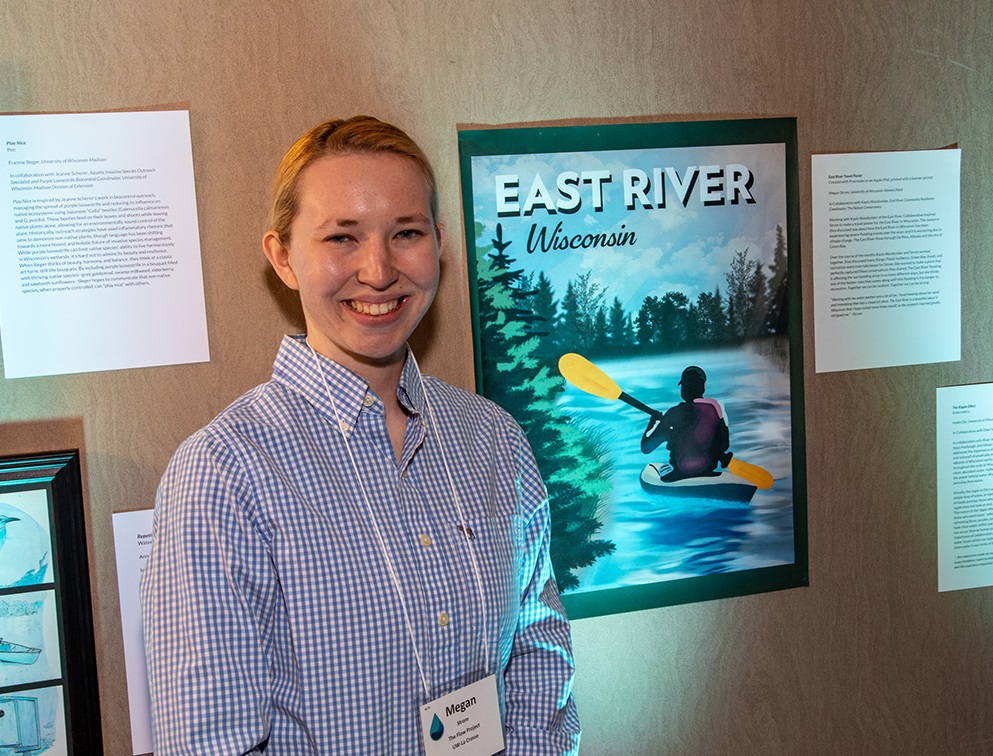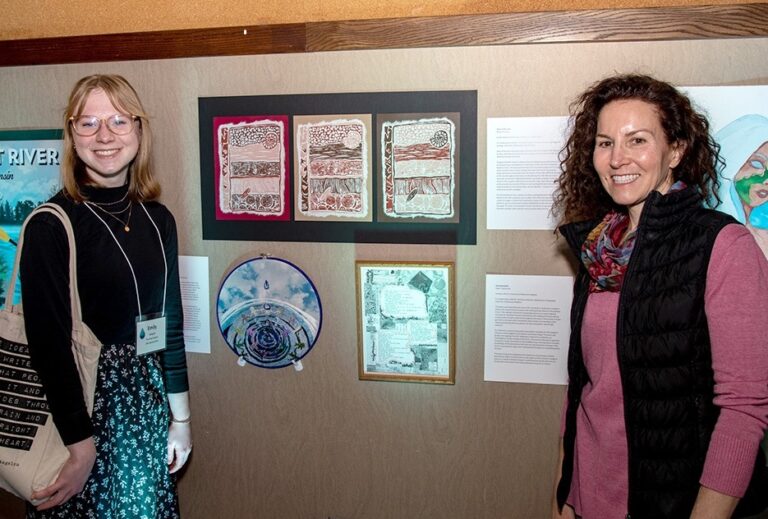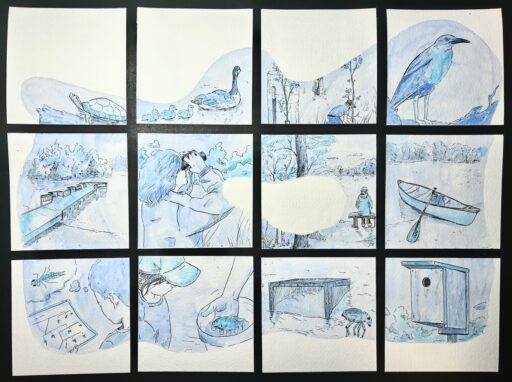
Megan Strom, graphic design major at UW-Stevens Point, poses with a travel poster she created for The Flow Project, which paired student artists and water professionals to create water-inspired art.
Art and science come together in a project that blends and flows as it illustrates water. The Flow Project was illuminating for both the artists and water professionals.
Seven UW-Stevens Point students are among 31 undergraduates from every UW who participated in The Flow Project. Student artists were paired with water professionals across the state to create art inspired by water. Students learned about the professional’s work or goals, then interpreted it in visual art including two-dimensional painting, drawing and photography, three-dimensional ceramics, fiber arts and beading and in performance art of music and dance.
“I’m so impressed with the art. Some look like they belong in a New York art gallery,” said Amy Kowalski, who helped coordinate the project. Communication specialist with Extension Lakes at UW-Stevens Point, she was one of the water professionals who worked with student artist Marcella Rose Schneider.
Schneider, a first-year-dance major from Neenah, choreographed a dance piece. Her interpretation shows the need for water, the need to protect it, connect with it and connect with people. Schneider and four other dancers – all UW-Stevens Point students – dressed in blue as they showed water flowing around obstacles, being pulled down and used in daily life for drinking, washing, growing. The dance begins and ends the same, as water cycles or ripples.
To demonstrate water’s unpredictability, they improvised a portion of the dance – which was challenging, Schneider said. “Part of growing is pushing yourself.”

Emily Odegard (left) created this block print of geologic layers after working with Samantha Kaplan, geography/geology professor at UW-Stevens Point. She is one of 31 student artists chosen for The Flow Project that is now on exhibit at the Portage County Library in Stevens Point.
“This was an amazing opportunity. I never imagined putting art together to spread awareness about a specific topic,” she said. “It was quite the journey.”
Kowalski inspired her to think about the importance of water and those committed to protecting it, Schneider said. “Amy said, ‘I just want to make the world better in a small way.’ I think we all want to do that.”
The Flow Project also was a great opportunity for Megan Strom, a graphic design major from Iron River, Mich. She worked with Kayla Wandsnider, East River community resilience coordinator for the Nature Conservancy, whose research focuses on flooding in the Green Bay-Appleton area.
Strom created a travel poster of a kayaker on the river. “Though the area is experiencing excessive flooding each year, we wanted to focus on the positives that the river brings,” she said. Recreation, fishing, and hiking attract visitors. Her goal was to draw attention to the impact flooding has on recreation.
Strom enjoyed turning large amounts of data into an easily digestible visual. “Flow gave me an incredible opportunity to learn and grow as a designer. Not only did I learn about water issues in Wisconsin, but I was able to learn new skills to deepen my work as a designer and collaborator.” She’s now interested in working as a designer in a scientific environment.
Anna Bartz, a web development major, also spends most of her creative time working with graphics. For this project, she created a watercolor and ink piece with Schmeeckle Reserve as the inspiration.
“I was drawn to how water makes an impact on Schmeeckle Reserve,” Bartz said. “My piece explores the history of recreation, research and refuge of the reserve.”
Her art features an aerial contour border depicting Lake Joanis that is in 12 individual squares. The top row portrays refuge, with animals who call Schmeeckle home shown in habitats. Across the middle, Bartz portrayed recreational opportunities such as canoeing and birdwatching. The bottom row of tiles represents biological research on the grounds of Schmeeckle over the years. To learn about various research underway at Schmeeckle, Bartz collaborated with outreach coordinator Melissa Ruether.

This contour of Schmeeckle Reserve was created by Anna Bartz, a web development major at UWSP. It is part of a project that paired student artists with professionals to create art inspired by water.
Bailey Boutin a fourth-year music education major studying voice at UW-Stevens Point, created a song for The Flow Project. “Cool Blue Water” is a jazz-inspired tune meant to remind listeners that “we aren’t so far removed from water and climate change,” Boutin said. He worked with Sophie LaFond-Hudson, Sea Grant Great Lakes fellow, whose research describes the resiliency of Lake Superior to climate change.
“We spoke about the commonality between folk music and water: both carry history and tradition. I wanted to deliver a positive message highlighting the change that humanity could enact, instead of focusing on the damage we have done,” he said.
Boutin created a lively rhythm section with digital backing of bass, electric guitar, drums and piano. He wrote and recorded vocals and improvised a melodica solo.
“I learned new things about my creative process,” he said. “Outside of academics, I had never been asked to compose a piece before, especially one about a particular topic. Overall, this process has been amazing.”
Both artist and water professional learn through these collaborations. That was the impetus for Project Director Julia Buskirk to launch The Flow Project with Alexandra Lakind at Water@UW-Madison in 2021.
From a young age, Buskirk loved art but found herself leaning toward a science major in college. “Water was my throughline,” where art and science intersect. Both require observing and expressing, she notes. “Flow artists help us explore the work we do around water in new ways and inspire us to ask new questions or reframe old ones. Water partners see their work differently after working with these artists.”
Also involved in The Flow Project were UW-Stevens Point students Arista Detter, Emilie McNeely and Emily Odegard and Professor Samantha Kaplan, geography/geology. UWSP staff who collaborated with students around the UW System and whose centers helped fund the project were:
- Lynn Markham, Center for Land Use Education
- Kevin Masarik, Center for Watershed Science and Education
- Sara Windjue, Extension Lakes
The exhibit debuted at the Wisconsin Lakes and Rivers Convention in Stevens Point, April 19-21. Select pieces will be displayed at the Portage County Library through May 21. The exhibit will then travel to De Pere and Madison this summer, then back to the Carlsten Art Gallery at UW-Stevens Point in October. It will also be in an online gallery at The Flow Project.
Written by UW-Stevens Point
Link to original story: https://www.uwsp.edu/news/flow-project-student-art-2023/
